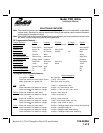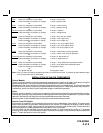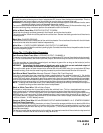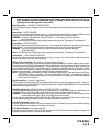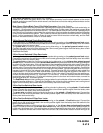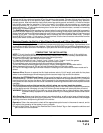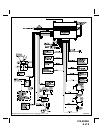
128-6620A
4 of 8
Dark Blue Wire: DELAYED 300 mA PULSED OUTPUT / CHANNEL 3
The dark blue wire pulses to ground via an independent RF channel from the keychain transmitter. This is a
transistorized, low current output, and should only be used to drive an external relay coil.
WARNING: Connecting the dark blue wire to the high current switched output of trunk release circuits, some
remote start trigger inputs, will damage the control module.
Connect the dark blue wire to terminal 86 of the AS - 9256 relay (or equivalent 30 A automotive relay), and
wire the remaining relay contacts to perform the selected function of channel 3.
White w/ Black Trace Wire: POSITIVE OUTPUT TO SIREN
Route this wire through a rubber grommet in the firewall, and to the siren location.
Connect the white / black wire to the positive wire of the siren. Secure the black ground wire of the siren to
chassis ground.
Black Wire: CHASSIS GROUND
Connect this wire to a solid, metal part of the vehicle’s chassis. Do not confuse this wire with the thin black
antenna wire that exits the control module independently.
White Wire: + 12 VDC PULSED PARKING LIGHT OUTPUT (15 AMP MAX)
This wire is provided to flash the vehicle’s parking lights. Connect the white wire to the positive side of one of
the vehicle’s parking lights.
Wiring The 11 Pin Mini Edge Connector:
Dark Green w/ Black Trace Wire: LATCHING OUTPUT / CHANNEL 4
The green w/ black trace wire latches to ground via an independent RF channel from the keychain transmit-
ter. This is a transistorized, low current (300 mA) output, and should only be used to drive an external relay
coil.
This wire provides an immediate ground signal, and stays at ground for as long as the button(s) on the
keychain transmitter remains pressed.
WARNING! Connecting the dark green w/ black trace wire to the high current switched output of
trunk release circuits will damage the control module.
Connect the dark green w/ black trace wire to terminal 86 of the AS 9256 relay (or an equivalent 30 Amp
automotive relay), and wire the remaining relay contacts to perform the selected function of channel 4.
Dark Blue w/Black Trace Wire: Alternate Channel 3 Output (Dbl. Push Required)
This wire is controlled from the transmitter button programmed to the receiver's channel 3. By double
pressing this the transmitter button, this output will become active for 1 second. This is a transistorized, low
current (300 mA) output, designed to provide an output only when the transmitter is intentionally operated,
such as is the case with remote start add on modules. If you require more than 300mA drive from this output,
you must drive an external relay coil, and arrange the relays contacts to preform the specified function.
NOTE: Pressing the transmitter button, then immediately pressing and holding it will cause this output to
be active as long as the transmitter button is depressed.
Black w/ White Trace Wire: 300 mA Horn Output
The black w/ white trace wire is provided to beep the vehicle’s horn. This is a transistorized low current
output, and should only be connected to the low current ground output from the vehicle’s horn switch.
If the vehicle uses a + 12 VDC horn switch, then connect the black w/ white trace wire to terminal 86 of the
AS 9256 relay (or an equivalent 30 Amp automotive relay), and connect relay terminal 85 to a fused + 12
VDC battery source. Connect relay terminal 87 to the vehicle’s horn switch output, and connect relay termi-
nal 30 to a fused + 12 VDC battery source.
Orange w/ White Trace Wire: 300 mA GROUND OUTPUT WHEN DISARMED - N. O. STARTER DISABLE
(Optional Relay Required).
This wire is provided to control the starter cut relay. Connect the orange w/white wire to terminal 86 of the
relay. Connect relay terminal 85 to an ignition wire in the vehicle that is live when the key is in the on and
crank positions, and off when the key is in the off position. (This is where the yellow wire from the alarm
should be connected).
Cut the low current starter solenoid wire in the vehicle, and connect one side of the cut wire to relay terminal
87. Connect the other side of the cut wire to relay terminal 30.
Page 4



